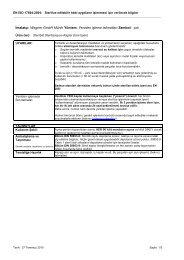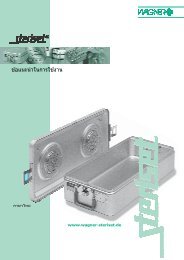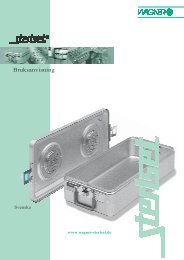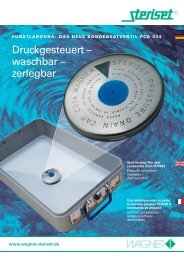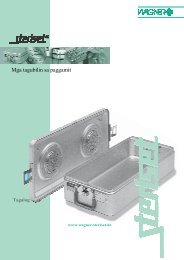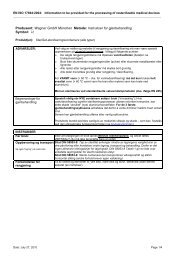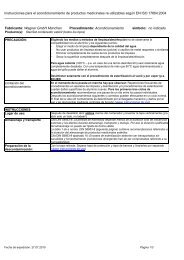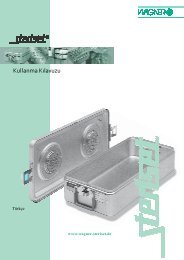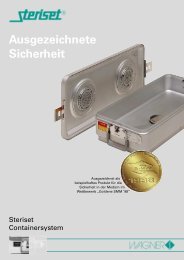Gebrauchsanweisung Instructions for use Notice d'utilisation ...
Gebrauchsanweisung Instructions for use Notice d'utilisation ...
Gebrauchsanweisung Instructions for use Notice d'utilisation ...
Create successful ePaper yourself
Turn your PDF publications into a flip-book with our unique Google optimized e-Paper software.
<strong>Gebrauchsanweisung</strong><br />
<strong>Instructions</strong> <strong>for</strong> <strong>use</strong><br />
<strong>Notice</strong> d’utilisation<br />
Instrucciones de Manejo<br />
Indicazioni per l’utilizzazione<br />
Deutsch<br />
English<br />
Français<br />
Español<br />
Italiano<br />
www.wagner-steriset.de
www.wagner-steriset.de<br />
SteriSet ® Container erfüllen die zutreffenden An<strong>for</strong>derungen:<br />
◆ der Europäischen Medical Device Directive (CE-Kennzeichnung<br />
in den Begleitpapieren)<br />
◆ der Normen EN 868-1:1997-05 (ersetzt durch: EN ISO 11607-1:2006-07)<br />
sowie EN 868-8<br />
◆ der Deutschen Normen DIN 58952/1 und DIN 58953/9<br />
◆ der Vertriebszulassung in USA (FDA 510K Premarketing Notification)<br />
SteriSet ® Container werden unter einem TÜV-zertifizierten Qualitäts-<br />
Management-System gemäß EN ISO 13485:2003 gefertigt.<br />
Viele Designmerkmale sind international patentgeschützt.<br />
SteriSet ® Containers meet the following requirements:<br />
◆ European Medical Device Directive (CE-mark declared)<br />
◆ European Standards EN 868-1:1997-05 (replaced by: EN ISO 11607-<br />
1:2006-07) and EN 868-8<br />
◆ German Standards (<strong>for</strong>mer DIN 58952/1 and actual DIN 58953/9)<br />
◆ FDA 510K Premarketing Notification <strong>for</strong> USA<br />
SteriSet ® Containers are manufactured in Germany, covered by a TÜVcertified<br />
Quality-Management-System acc. EN ISO 13485:2003<br />
The design is protected by multiple international patents.<br />
SteriSet ® und ThermoLoc ® sind eingetragene Warenzeichen.<br />
Technische Änderungen vorbehalten<br />
SteriSet ® and ThermoLoc ® are registred trademarks<br />
Technical modifications reserved<br />
© April 2008
1 2 3<br />
5 6 7 8<br />
9 10 11<br />
12 13 14<br />
16 17 19<br />
18<br />
20 21 22<br />
23<br />
4<br />
15<br />
24
The SteriSet System<br />
SteriSet-Containers are reusable, metal,<br />
sterilization containers. They are <strong>use</strong>d<br />
<strong>for</strong> holding operating room instruments<br />
and/or textiles during vacuum-steam<br />
sterilization procedures and <strong>for</strong> main-<br />
taining sterility during storage and transport<br />
under proper hospital conditions.<br />
The containers are intended <strong>for</strong> <strong>use</strong> by<br />
specialist trained professionals and their<br />
assistants working in the fields of hospital<br />
hygiene and sterilization technology.<br />
This <strong>use</strong>r manual describes important<br />
instructions on the proper <strong>use</strong> and care<br />
of SteriSet containers, and – without<br />
claiming to be comprehensive – outlines<br />
a number of possible hazards that<br />
could result from failure to observe the<br />
instructions.<br />
Compatibility warning!<br />
If the SteriSet-Containers are <strong>use</strong>d in combination<br />
with components or articles (filters,<br />
seals, etc.) from another manufacturer, then<br />
sterility and/or the functioning of the antibacteria<br />
barrier, etc. is no longer guaranteed!<br />
Only combine WAGNER sterile container<br />
products!<br />
Filter or Valve System<br />
SteriSet filter containers are containers<br />
with a closed (unper<strong>for</strong>ated) base and<br />
per<strong>for</strong>ated filter lid (covered by a protective<br />
lid). They are intended to be <strong>use</strong>d<br />
with single <strong>use</strong> (disposable) filters made<br />
from sterilization paper.<br />
In case of <strong>use</strong> of filters which are not<br />
supplied by WAGNER, the <strong>use</strong>r must<br />
validate the permeability and barrier<br />
properties himself.<br />
SteriSet valve containers are containers<br />
with a closed (unper<strong>for</strong>ated) base and<br />
a permanent stainless-steel pressuresensitive<br />
valve in the inner lid. These<br />
sterilization valves react to the change<br />
in pressure within the sterilizer.<br />
◆ during the vacuum phase, the valve<br />
opens upwards, and the air/steam<br />
mixture flows out of the container<br />
◆ during the pressurization phase, the<br />
valve opens downwards and thus<br />
allows steam to flow in. The system<br />
is automatically flushed and sterilised<br />
by the steam rushing through the<br />
valve during every sterilization cycle<br />
◆ when not in the sterilizer (i.e. during<br />
storage and transport under specified<br />
conditions; see section on „Storage“),<br />
the sterilizing valve is closed and a<br />
barrier to microorganisms.<br />
SteriSet containers are suitable <strong>for</strong><br />
<strong>use</strong> in validated steam sterilizers using<br />
vacuum processes (e.g. DIN 58946<br />
/EN 285 / ANSI/AAMI/ISO 11134-1993,<br />
ST46-1993) and are evaluated <strong>for</strong><br />
suitability in accordance with EN 868-8.<br />
Validation<br />
The latest technical standards require the<br />
<strong>use</strong>r to validate the sterilization procedure<br />
(e.g. in accordance with EN 554/ISO 13863)<br />
even when the sterilizer being <strong>use</strong>d has<br />
been built in accordance with one of the<br />
above standards, as it may otherwise not<br />
be possible to guarantee the attainment of<br />
sterility.<br />
Caution<br />
With loads comprising solely instruments<br />
(i.e. containing no porous items such as<br />
textile packs, etc.), then (simple) prevacuum<br />
procedures may also be suitable (validation!).<br />
Hot-air sterilization, gravity or circulation<br />
procedures and also <strong>for</strong>maldehyde or ethylene<br />
oxide sterilization or other substitute<br />
procedures <strong>for</strong> the sterilization of thermolabile<br />
products such as plasma sterilization<br />
or peroxide sterilization may not be <strong>use</strong>d.<br />
Mis<strong>use</strong><br />
Careless handling or the <strong>use</strong> of inappropriate<br />
chemicals can ca<strong>use</strong> damage to the sterilization<br />
containers, thereby putting at risk<br />
the ability to attain and preserve sterility.<br />
Example: Never <strong>use</strong> disinfection solutions<br />
containing halogen or chloride – there is a<br />
danger of corrosion even <strong>for</strong> stainless steel<br />
containers. SteriSet containers there<strong>for</strong>e<br />
require regular visual and, if necessary,<br />
functional checks.<br />
Servicable Life<br />
After 5000 cycles of accelerated aging<br />
in accordance with EN 868-8 Annex<br />
G, the tested (seal/gasket function and<br />
barrier properties) SteriSet Containers<br />
showed no functional changes .<br />
The end of serviceable life tends to be<br />
determined by mechanical wear and<br />
tear and damage rather than frequent<br />
<strong>use</strong> of the container <strong>for</strong> its intended<br />
purpose and can be identified by the required<br />
control of function be<strong>for</strong>e re<strong>use</strong>.<br />
Maintenance<br />
During storage, sterilization containers<br />
are better than disposable soft<br />
packages at protecting sterile goods<br />
from recontamination ca<strong>use</strong>d by, <strong>for</strong><br />
example, mechanical load / damage.<br />
Like all reusable equipment, however,<br />
the SteriSet container although robust<br />
also needs to be treated with care<br />
in order to ensure that its protective<br />
qualities are preserved.<br />
◆ Only <strong>use</strong> Steriset containers following<br />
the instructions in this <strong>use</strong>r manual.<br />
◆ Relevant personnel must there<strong>for</strong>e<br />
be familiar with the correct handling<br />
practices.<br />
◆ Make sure the <strong>use</strong>r manual is easily<br />
accessible <strong>for</strong> relevant personnel.<br />
◆ Observe current standards.<br />
◆ Carefully follow the general guidelines<br />
and hygiene principles on handing<br />
contaminated products, products<br />
awaiting sterilization and products<br />
which have been sterilized.<br />
Be<strong>for</strong>e using the sterile container,<br />
or after any accident (such as<br />
being dropped on the ground), it is<br />
essential that the sterile container<br />
undergoes a thorough visual and<br />
functional check <strong>for</strong> damage.<br />
Never <strong>use</strong> a damaged or defective<br />
sterile container!<br />
Deutsch<br />
English<br />
Français<br />
Español<br />
Italiano<br />
9
Deutsch<br />
English<br />
Français<br />
Español<br />
Italiano<br />
10<br />
Control of Function<br />
Undamaged shape<br />
The seating of the seals on the upper<br />
rim of the container base tray and on the<br />
inner lid must be free of dents and visible<br />
de<strong>for</strong>mations. Neither the lid nor filter plate<br />
nor the tray may show noticeable buckling<br />
or holes.<br />
Seal<br />
The seal in the inner lid (and filter plate<br />
button, filter plate and condensate drain<br />
if applicable) must be completely inserted<br />
and undamaged.<br />
Handles and clasps<br />
Handles, closure clasps and similar fittings<br />
must not be loose (no „wobble“). The<br />
closure clasps must lock the lid firmly to<br />
the bottom of the container.<br />
Filters or valves<br />
Neither filters / valves nor filterplates or<br />
valve covers (see pic. 8 - the per<strong>for</strong>ated<br />
disc sections) may show visible<br />
mal<strong>for</strong>mations.<br />
The seals on the filter plates, the lock pin<br />
on the lid must not be damaged and filters<br />
must fully cover the visible per<strong>for</strong>ations in<br />
the lid. The filters are to be subjected to<br />
visual and mechanical inspections (see pics<br />
6-8 and 20–22) .<br />
Containers with condensate drain valves<br />
The condensate valve must be screwed<br />
in correctly with the attached seal and be<br />
spring-tensioned (check the spring tension<br />
by thumb pressure with the valve screwed<br />
in position. To screw in the valve, press<br />
vertically downwards whilst at the same<br />
time turning clockwise until it clicks into<br />
place. See pics. 23, 24).<br />
23<br />
24<br />
6<br />
7<br />
8<br />
20<br />
21<br />
22<br />
Tamper-Proof<br />
Sealing<br />
Sealing<br />
It is recommended and required by<br />
the latest technical standards (DIN EN<br />
ISO 11607-1 5.1 10c) that containers<br />
are sealed in such a way as to prevent<br />
inadvertent opening of containers and<br />
to ensure that it is evident whether<br />
or not a container has been opened.<br />
SteriSet containers offer two alternative<br />
methods <strong>for</strong> this:<br />
1. Disposable plastic<br />
seals which, once<br />
attached, can be open-<br />
ed only by breaking.<br />
They are inserted<br />
through the horizon-<br />
tal hole in the closure be<strong>for</strong>e sterilization,<br />
and fastened between thumb and index<br />
finger (press fully together, but do not<br />
snap off!).<br />
To unseal /open: Insert, <strong>for</strong> example, an<br />
index finger and TWIST (do not pull –<br />
see diagram 1–3).<br />
If seals purchased from a company<br />
other than Wagner are to be <strong>use</strong>d, the<br />
<strong>use</strong>r has to make sure that containers<br />
are sealed in such a way as to prevent<br />
inadvertent opening of containers and to<br />
ensure that it is evident whether or not<br />
a container has been opened.<br />
2. The „automatic<br />
sealing“ option<br />
(ThermoLoc): Containers<br />
with this type<br />
of closure indicate<br />
sealing automatically<br />
as a result of the heat during sterilization<br />
procedure. In the sealed condition,<br />
a diagonal red block appears below<br />
the closure. To unseal, push the block<br />
vertically upwards until the red block<br />
has disappeared into the housing. Only<br />
then can the clasp be released (see<br />
diagram 12–14).<br />
Safety note<br />
The sealing function of ThermoLoc may only<br />
be reset after cool down (app. 10 minutes<br />
after removal from the sterilizer). Resetting<br />
the seal be<strong>for</strong>e cool down would require<br />
application of <strong>for</strong>ce and gloves to be worn<br />
(hot!) and might ca<strong>use</strong> the (still hot) latch to<br />
reappear after the lid latch was opened. After<br />
cool down the seal can be reset without<br />
dropping down again. Such the first opening<br />
since cool down is clearly indicated.
Sterilization<br />
Beca<strong>use</strong> of their safety-cover design,<br />
SteriSet containers can also be sterilized<br />
whilst stacked.<br />
Stack height:
Deutsch<br />
English<br />
Français<br />
Español<br />
Italiano<br />
12<br />
Security<br />
Data cards / indicators<br />
We recommend the <strong>use</strong> of documentation<br />
cards with chemical process<br />
indicators in the outer holding frame of<br />
the container (see also DIN 58953/9).<br />
These cards help substantiate that the<br />
containers were treated correctly, and<br />
facilitate per<strong>for</strong>mance documentation.<br />
The additional <strong>use</strong> of chemical sterilization<br />
indicators inside the containers<br />
is not absolutely necessary. Such<br />
indicators are basically able to prove<br />
that a sterilization procedure has been<br />
per<strong>for</strong>med, but are just as unable as<br />
an external card to indicate whether<br />
the contents of the container actually<br />
attained sterility (they indicate only that<br />
the contents at the location of indicator<br />
were sterile). If they are <strong>use</strong>d, we<br />
recommend that they are placed in the<br />
middle of the load as this is usually the<br />
most critical point.<br />
The <strong>use</strong> of, <strong>for</strong> example, a single<br />
chemical indicator in a specific „worst<br />
case“ test receptacle is considered<br />
to be a sensible alternative to batch<br />
documentation obtained by placing<br />
chemical in-, dicators in every single<br />
sterile pack. If such a „worst case<br />
pack“ signals „sterile“, then there<br />
is a much smaller probability of the<br />
procedure having failed (<strong>for</strong> example as<br />
a result of spontaneous changes such<br />
as insufficient air circulation ca<strong>use</strong>d by<br />
faulty door seals) than if indicators are<br />
place in a normal container.<br />
Note<br />
The batch documentation does not replace<br />
regular checking and documentation of the<br />
sterilizers (ventilation tests; sterilization<br />
tests with chemical and biological indicators;<br />
vacuum-leak tests, etc.).<br />
Caution<br />
If procedure indicators are not <strong>use</strong>d,<br />
then other organizational measures should<br />
ensure that no unsterilized – and thus<br />
non-sterile – containers are inadvertently<br />
released.<br />
Condensation valve<br />
Some drying problems with instruments<br />
(such as overloaded instrument sets)<br />
can be solved only by using a container<br />
fitted with a condensate drain valve in<br />
the base. Such containers are equip-<br />
ped with a sump with a central outlet,<br />
which is tightly closed by a temperaturecontrolled<br />
valve. The valve opens in<br />
134°C programmes when the temperature<br />
rises above 130°C, thereby<br />
allowing condensate to drain out during<br />
sterilization.<br />
During the drying phase, the condensate<br />
valve closes while still inside the<br />
sterilizer when the temperature first<br />
drops below 110 °C. It re-opens only<br />
when the temperature again rises above<br />
130 °C, which means that this option<br />
is associated with absolutely no risks<br />
at typical removal temperatures of<br />
75 – 80 °C.<br />
121 °C program<br />
Standard condensation valves do not<br />
open during the 121°C sterilization<br />
programme <strong>for</strong> the above reasons (a<br />
condensation valve <strong>for</strong> 121 sterilization<br />
is optionally available)<br />
Note:<br />
For containers with condensate drain valves<br />
in the base, the condensate should be able<br />
to drip to the base unimpeded. This can be<br />
achieved by using cloth wraps with a central<br />
hole. The recommended dimensions <strong>for</strong> the<br />
hole in the cloth are 40x20 cm (or 20x20 cm<br />
<strong>for</strong> half-size containers).<br />
No prolonged exposure<br />
Containers shall be removed from the<br />
sterilizer at program end, latest within<br />
1 hour after program end: if left <strong>for</strong> a<br />
prolonged period in the closed, heated<br />
chamber, the drain‘s switch temperature<br />
could be reached again, such re-open the<br />
drain valve and introduce the risk of non<br />
sterility when taking out!<br />
Specifically in the case of small load<br />
sterilization (
After Sterilization<br />
After Sterilization<br />
hot<br />
To safeguard against accidents (burns,<br />
dropping, etc.), containers that are still<br />
hot should never be handled with bare<br />
hands, even despite the thermally insulated<br />
handles (silicon coating).<br />
After removal from the sterilizer, the<br />
containers should not be cooled to room<br />
temperature too rapidly (e.g. do not<br />
place on cold surfaces or expose to a<br />
cold draught), as excessively rapid<br />
external cooling can lead to recondensa-tion<br />
of the water vapour inside the<br />
container with an unwanted accumulation<br />
of condensate.<br />
◆ A cooling time of 30 minutes should<br />
be allowed be<strong>for</strong>e handling containers<br />
(as detailed in DIN 5895379;2000)!<br />
Storage / Transport<br />
Sterility can be maintained inside<br />
proper packaging during clean hospital<br />
storage <strong>for</strong> a practically unlimited<br />
period. Depending upon storage<br />
duration and conditions, however,<br />
external contamination occurs, and<br />
this represents a potential risk during<br />
subsequent <strong>use</strong>, transport and aseptic<br />
presentation. According to scientific<br />
research (see also DIN 58953/9;2000)<br />
this risk factor can be reduced by the<br />
following measures:<br />
◆ The <strong>use</strong> of internal packaging<br />
◆ Storage under (dust)-protected<br />
conditions<br />
◆ Limitation of the storage period<br />
DIN 58953 part 9: Sep 2000 (table 2)<br />
recommends, – without claim to be<br />
comprehensive, – to limit storage<br />
duration to 6 months (dust protected<br />
and dry storage provided – with or<br />
without internal packaging), but also<br />
references to the responsibility of the<br />
medical director to lay down the acceptable<br />
storage duration individually.<br />
Other important points are<br />
◆ Dry storage under controlled conditions<br />
(low air-contamination, constant humidity,<br />
etc.)<br />
◆ Handling as vibration-free as possible<br />
◆ Packaging mechanically undamaged<br />
If these points are followed, then the<br />
risk of recontamination will be essen-<br />
tially restricted to the effects of external<br />
contamination accumulated during storage.<br />
Unlike other types of packaging,<br />
the protective cover concept of the<br />
SteriSet containers is a simple method<br />
of eliminating this potential risk (e.g. by<br />
swab disinfection of the protective lid or<br />
using the S-model). We nevertheless<br />
recommend following DIN 58953/9;<br />
2000 –“Operation procedures <strong>for</strong><br />
sterilization containers.“<br />
Special cases<br />
When storing or transporting sterile<br />
containers under non-standard hospital<br />
conditions (e.g. ho<strong>use</strong>-external transport;<br />
strong vibration, extreme changes in<br />
temperature, when there is a danger of<br />
contact with fluids, high humidity, or rapid<br />
pressure changes due to transportation<br />
in aeroplanes or trucks), then internal<br />
packaging and transport packaging to<br />
protect against dust contamination should<br />
be <strong>use</strong>d to reduce the associated risks.<br />
Aseptic presentation<br />
The contents of a container can only<br />
be considered sterile if the container<br />
has been correctly sterilized and at the<br />
time of opening its lock has not been<br />
tampered with. If containers are to be<br />
opened after a long period of storage or<br />
after storage under non-ideal conditions,<br />
then we recommend either using the<br />
S model (protective cover removable<br />
separately as a first stage, see figs.<br />
16–19) or wiping the unper<strong>for</strong>ated cover<br />
with a disinfectant be<strong>for</strong>e handling.<br />
Caution<br />
In general containers should be handled<br />
in such a way that mechanical damage is<br />
minimized. Both lid latches of the container<br />
must opened to allow to lift the lid up<br />
completely. Opening only one side (latch)<br />
with the other side still closed will very likely<br />
damage the still closed latch or closure and<br />
as such hamper the integrity<br />
of the container.<br />
13<br />
Deutsch<br />
English<br />
Français<br />
Español<br />
Italiano
Deutsch<br />
English<br />
Français<br />
Español<br />
Italiano<br />
14<br />
Cleaning and Disinfection<br />
In the operating room SteriSet containers<br />
are normally protected from direct contamination<br />
with blood or protein, as they<br />
are covered with sheets or are removed<br />
from the room be<strong>for</strong>e the operation<br />
starts.<br />
Experience has shown that optically<br />
„clean“ containers are there<strong>for</strong>e not<br />
microbiologically burdened (bioburden)<br />
to such an extent that this can influence<br />
the effectiveness of sterilization.<br />
However, if this cannot be excluded<br />
(inspection by hygiene control personnel,<br />
<strong>for</strong> example by surface contact<br />
trials),containers should be cleaned/disinfected<br />
be<strong>for</strong>e the next <strong>use</strong>.<br />
Compatibility with materials<br />
Container bases (trays), inner lids<br />
and outer lids are made of anodized<br />
aluminium. The fittings, and valves (and<br />
also the protective cover if this option<br />
is chosen) are made of electrolytically<br />
polished, chemically resistant stainless<br />
steel 1.4301. When selecting cleaning<br />
and disinfection agents and methods,<br />
particular attention must be paid to<br />
tolerance by aluminium as well as the<br />
following points:<br />
◆ Do not <strong>use</strong> lathering cleaning<br />
substances (powder) or abrasive<br />
metal brushes or similar.<br />
◆ Do not <strong>use</strong> substances containing<br />
halogen or chloride, there is a danger<br />
of corrosion, even on stainless steel!<br />
◆ Thorough rinsing must remove all<br />
cleaning agent residues.<br />
◆ The individual parts must be<br />
thoroughly dried and stored in a dry<br />
place following cleaning/disinfection,<br />
◆ The selected cleaning agents must<br />
be appropriate <strong>for</strong> the quality of the<br />
available water: For thermal cleaning<br />
and disinfection (first choice) we<br />
recommend:<br />
◆ in case of fully desalinated water:<br />
cleaning with i.e. the pH-neutral<br />
enzymatic cleaner NEODISHER<br />
MEDIZYM at app. 55 °C or MediClean<br />
up to 60°C or Medi Clean Forte at<br />
max. 45°C and subsequent thermodisinfection<br />
during final rinsing by <strong>use</strong><br />
of fully desalinated water.<br />
Note<br />
NEODISHER is a registered trademark of „Chemische<br />
Fabrik Dr. Weigert“, Hamburg, Germany<br />
◆ Cleaning in case of only softened<br />
water: <strong>use</strong> of mild alkaline, nonchlorous<br />
substances (such as<br />
NEODISHER SeptoClean/liquid or<br />
NEODISHER MA/powder) at appr. 55<br />
oC followed by thermodisinfection<br />
with fully desalinated water<br />
For chemical cleaning and disinfection<br />
(2nd choice) we recommend:<br />
Use of pH-neutral or weak acidic<br />
substances such as NEODISHER<br />
Dekonta (a combined cleaning &<br />
disinfection product) and:<br />
◆ in case of fully desalinated water:<br />
Use of a neutral final rinse aid such as<br />
neodisher TN.<br />
◆ in case of only softened water:<br />
Use of a mild alkaline, soft water<br />
compatible final rinse aid such as<br />
neodisher TS.<br />
Waterquality<br />
Please note:<br />
a) Regular tap water can only be <strong>use</strong>d<br />
cold,and thus is unsuitable <strong>for</strong> washing.<br />
b) Softened water should only be <strong>use</strong>d<br />
up to max. 60 °C :<br />
■ Rinsing: only
Wagner GmbH<br />
Fabrik für medizinische Geräte<br />
Schulstraße 16 a<br />
D-80634 München/Germany<br />
Telefon +49 (89) 121101-0<br />
Fax +49 (89) 13 30 99<br />
info@wagner-sterilsysteme.de<br />
www.wagner-steriset.de



